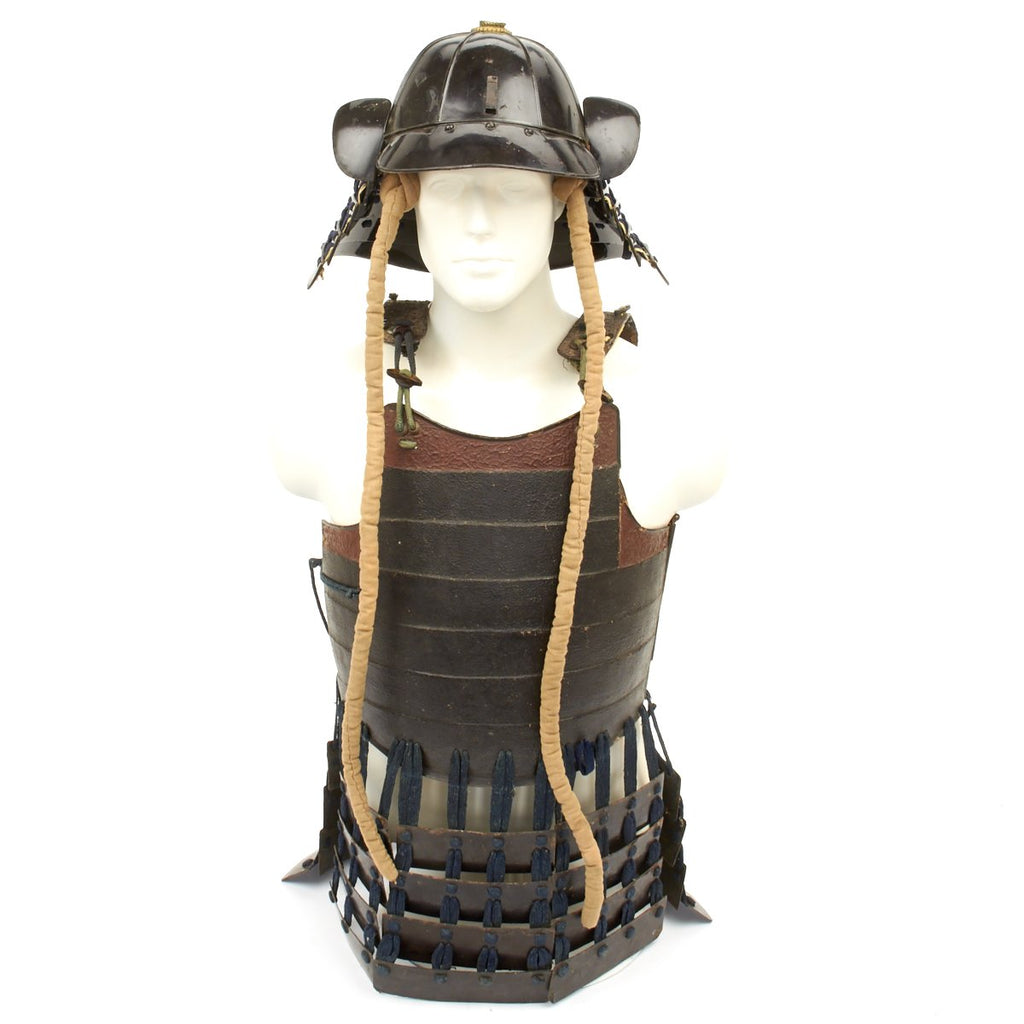-
Original Item: One-of-a-kind set. Japanese armor is thought to have evolved from the armor used in ancient China and Korea. Cuirasses and helmets were manufactured in Japan as early as the 4th century. Tankō, worn by foot soldiers and keikō, worn by horsemen were both pre-samurai types of early Japanese cuirass constructed from iron plates connected together by leather thongs.
During the Heian period (794-1185), the Japanese cuirass evolved into the more familiar style of armor worn by the samurai known as the dou or dō. Japanese armor makers started to use leather (nerigawa) and lacquer was used to weather proof the armor parts. By the end of the Heian period the Japanese cuirass had arrived at the shape recognized as being distinctly samurai. Leather and or iron scales were used to construct samurai armors, with leather and eventually silk lace used to connect the individual scales (kozane) which these cuirasses were now being made from.
In the 16th century Japan began trading with Europe during what would become known as the Nanban trade. Samurai acquired European armour including the cuirass and comb morion which they modified and combined with domestic armour as it provided better protection from the newly introduced matchlock muskets known as Tanegashima. The introduction of the tanegashima by the Portuguese in 1543 changed the nature of warfare in Japan causing the Japanese armor makers to change the design of their armours from the centuries-old lamellar armours to plate armour constructed from iron and steel plates which was called tosei gusoku (new armours). Bullet resistant armours were developed called tameshi gusoku or (bullet tested) allowing samurai to continue wearing their armour despite the use of firearms.
The era of warfare called the Sengoku period ended around 1600, Japan was united and entered the peaceful Edo period, samurai continued to use both plate and lamellar armor as a symbol of their status but traditional armours were no longer necessary for battles. During the Edo period light weight, portable and secret hidden armors became popular as there was still a need for personal protection. Civil strife, duels, assassinations, peasant revolts required the use of armours such as the kusari katabira (chain armor jacket) and armored sleeves as well as other types of armour which could be worn under ordinary clothing. Edo period samurai were in charge of internal security and would wear various types of kusari gusoku (chain armor) and shin and arm protection as well as forehead protectors (hachi-gane).
Armour continued to be worn and used in Japan until the end of the samurai era (Meiji period) in the 1860s, with the last use of samurai armor happening in 1877 during the Satsuma Rebellion.
Construction
Japanese armor was generally constructed from many small iron (tetsu) and/or leather (nerigawa) scales (kozane) and/or plates (ita-mono), connected to each other by rivets and macramé cords (odoshi) made from leather and/or braided silk, and/or chain armor (kusari). Noble families had silk cords made in specific patterns and colors of silk thread. Many of these cords were constructed of well over 100 strands of silk. Making these special silk cords could take many months of steady work, just to complete enough for one suit of armour. Japanese armour was designed to be as lightweight as possible as the samurai had many tasks including riding a horse and archery in addition to swordsmanship. The armour was usually brightly lacquered to protect against the harsh Japanese climate. Chain armour (kusari) was also used to construct individual armor pieces and full suits of kusari were even used.
This Example
This example is offered in very good condition. It is comprised of iron with cloth woven connection cords. The helmet features a fabric lined interior. Colors are black, blue and deep red. Dates from the first half of the 19th century during the Edo period. The chest plate is signed in Kanji with red paint. This is genuine period armor, not reproduction, much more research can, and should, be conducted.
- This product is available for international shipping.
- Eligible for all payments - Visa, Mastercard, Discover, AMEX, Paypal & Sezzle


We Buy Military Antiques
Our team expert buyers travels the world to pay fair prices for entire estate collections to singular items.
START SELLING TODAY
































